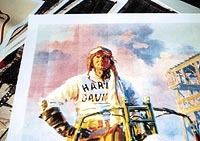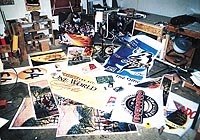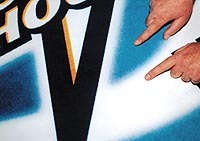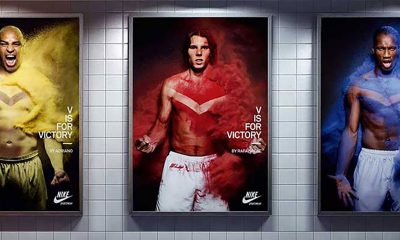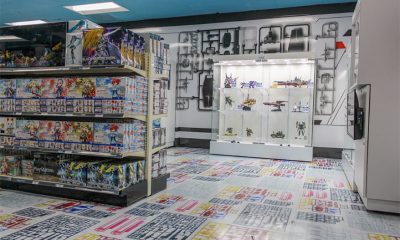Banners + Awnings
Solving the World’s Digital Media Problems
Instead of throwing away materials and profit, find the answers to vexing daily problems
Published
18 years agoon
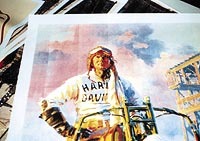
Ask signmakers what problems they encounter with digital media, and you’ll hear some very colorful language. Yet I see billboards, posters and vehicle graphics everywhere, and I know signmakers have answers to questions about media.
After talking to selected signshops and manufacturers, I can solve the world’s digital-media problems in just one word — but you’ll have to wait for that. First, you must absorb the tips and tricks gathered from industry professionals as they discuss media problems and solutions. Foreign particles David Kaplan of Signs Etc. (Cedar Rapids, IA) says his shop attracts customers with the motto, "Vinyl is final." Knowing this is not really true, David says customers really like vinyl’s fast processing, ability to resist fading and reproducibility. Signs Etc. started 10 years ago as a vinyl franchise and produces roughly 35% of its business as digital color prints. He says, "Ready-to-go media products are not necessarily ‘ready.’ They’re fabricated in a ‘clean’ environment, but when dust falls onto a roll at the shop, it creates a little dent in the vinyl. Then when you prepare to print, the ink is imperfect in that spot." Suggestion: To fix this problem, David uses the talents he was given. "Well, I swear a lot. Then, I take a permanent felt marker and do a little dab. If the imperfection is very noticeable and the print will be used outdoors, we reprint the whole thing," he explains. Puckering When printing on regular paper, Tito Torres of Envisions Digital Inc. (Spokane, WA) finds that the ink’s moisture makes the paper pucker. After laminating, he says there are fewer pucker problems. "We could fix this by using better quality paper, but then the supplies cost goes up," he says. This indicates a bigger problem that many shops face — pricing against the competition. Suggestion: "We compete by offering creative ideas, better service, fast turnaround and a quality product," Tito says. Humidity Dana Goodale, marketing product manager for Gerber Scientific Products (South Windsor, CT), has seen and solved many media problems over the 12 years he’s been in the business. Dana says one of the most common misprinting scenarios happens when using paper-backed media on a humid day.Gerber Scientific Products Suggestion: Dana recommends exposing the length of the material to be printed on to the humid air. "If you don’t expose the material to the humid air, it can absorb the moisture between each color pass, which changes the print with every pass," he explained. He also suggests using media with plastic backing, which absorbs less moisture. Experiment costs Gavin Jackson of Visual Horizons (Modesto, CA), a 25% digital-printing/ vinyl shop that specializes in vehicle graphics, has used a Roland DGA Corporation CAMMJET for almost three years. Concerned about the material costs of running a digital business, Gavin works to reduce any media problems.Roland DGA Corporation Suggestion: Gavin contacted many companies that sent product samples because they wanted his business. The printed ink peeled off certain vinyls, but he found a product he could live with. "I tried many different materials when I got the printer," he says. "Cast vinyls are good, they even conform to large rivets." WYSIWYG Sharon Welz of Sign Pro (Roswell, NM), a vinyl franchise shop that credits 40% of its sign business to digital printing, addresses a problem found in most shops polled: What you see on the computer screen is not always what appears on the print. "You don’t know what it’s going to be until you print it," she says. "Even when you hit ‘Show Fill,’ it’s not exactly how it’s going to be." Suggestion 1: Sharon says, "Always check to see if your substrate matches your idea of the finished product. You have to remember that there’s a vinyl color under there, and it’s not always what you expect." Additionally, you might investigate other, more sophisticated RIPs, as well as pre-flight pre-press software. Suggestion 2: For the best "color-pop," Jim Allen, Forbo-Stamoid’s (Swedesboro, NJ) vice president of sales, suggests starting with the whitest paper available. "Forbo-Stamoid produces a bright-white formatted paper, which is almost the same as pre-press paper, that yields brighter colors," Jim says. Non-registering cutlines Bill Lynch of Century Sign (Hamden, CT), a commercial/electric shop that produces about 40% digital products, says his software has problems creating a cut-line around a multicolored image. "A software decal-cut option is supposed to transfer the outline of the entire object so the cutter can pick it up. But some programs aren’t accurate and incorrectly select different layers of a design and make those the cut-lines," he explains. "The result — part of the decal is cut off or shows a rim of unprinted media. Suggestion 1: To counteract this situation, Bill selects the outlines of all layers, copies them to a new page and removes the color. Then he places an outline around the simplified shape to create a new accurate cutting line. Suggestion 2: To avoid cutting decals or full-color images that have a rim of white, Dana suggests "bleed-cutting," or increasing the shape’s print size while maintaining the cut size so that no white shows when you are cutting. Beta-test problems Adding yet another tip, David says Signs Etc. is a beta test site for Gerber software. "Any new software has bugs so companies do their own laboratory tests and run beta tests through actual shop users," he says. Sign Etc., one of the first Gerber EDGE customers, uses the thermal-transfer printer daily for four-color process work on vehicles to produce fades, outlines and shadows. "The Edge is a huge reason we’ve grown as fast as we did," he says, "For the Edge, nothing beats Gerber software." "Beta testing is not for everybody," says Dana. "because the beta-tested item is not a final-release product. We wring out the products before they get to beta, but one of the functions of beta testers is to find the unexpected." "The best testers are those who call after they’ve tried something and say what works and what doesn’t," Dana says. "This way, the manufacturer can make final changes and adjustments before the product is released." Suggestion: To test new software, load it on a system you don’t normally use, as opposed to your main production system. Universal pre-coat adhesive Dorothy Simpson Krause (Marshfield Hills, MA) is a computer-graphics professor at the Massachusetts College of Art and member of Digital Atelier, a digital-art printmaking collaborative. From a digital printshop’s standards, Dorothy runs unusual material through her machines. One thing Dorothy needs is a generic pre-coat that will spray or roll over any substrate, including aluminum and plaster. She admits there are a few available products, but nothing suitable. "Some things aren’t available to a small shop that wants to use it on a specific substrate," she says. Suggestion: Dorothy uses different substances, including rabbit-skin glue and kaolin to prepare a variety of surfaces for print, but she says rabbit-skin glue is a pain to process — you must melt the glue beads down, add water and mix carefully, etc. Banding or white streaks One common complaint from more than half the signmakers we interviewed was the appearance of streaks, banding or white lines on their digital prints. Suggestion: For help with white lines, Dana suggests using "chokes and spreads," a screenprinting technique of printing one color slightly larger, then overlapping the colors that butt together. Choosing which color should overlap takes planning. For example, black would show through yellow but not the reverse. Another way to eliminate white banding is changing a regular pen line into a calligraphy-type line and overprinting it. This function gives the line thickness without making the object bigger. Bubbling and curling Imagine this: You get through pre-press and print productions beautifully, but then, while laminating, your print bubbles or curls. Some shops say they don’t have to imagine this problem, and often, the laminator isn’t the only thing generating heat in the shop. Here, LexJet Direct (Sarasota, FL) recommended two techniques for the discouraged signmaker. Suggestion 1: If you experience bubbles or air pockets when laminating pressure-sensitive material, reduce the machine’s speed. After applying the laminate, allow curing for a minimum of two hours. Most adhesives fully set in 24 hours. Suggestion 2: Since ink formulations are often changed, always run a proof with the paper and the inks you’ll be using. Also, make sure the inks have dried thoroughly before laminating. Prints that are tacky to the touch have not dried completely. Color matching Mark Johnson of Husky Signs and Graphics (Boulder, CO), a 50% digital work-vinyl shop, says he has experienced ongoing problems with his printer and software color matching, overlap feed and banding. "Before printing with new media, we run tests to determine the specs for that material," he says. Suggestion: Mark often handles the difference in color matching by telling customers upfront that their colors may not conform to PANTONE

SPONSORED VIDEO
Introducing the Sign Industry Podcast
The Sign Industry Podcast is a platform for every sign person out there — from the old-timers who bent neon and hand-lettered boats to those venturing into new technologies — we want to get their stories out for everyone to hear. Come join us and listen to stories, learn tricks or techniques, and get insights of what’s to come. We are the world’s second oldest profession. The folks who started the world’s oldest profession needed a sign.
You may like

Neon Museum of Saint Louis Holding Fundraiser

The Seasons of Sign Entrepreneurship

This Sign Company Absolutely Hates Price Shoppers
Subscribe

Bulletins
Get the most important news and business ideas from Signs of the Times magazine's news bulletin.
Most Popular
-

 Paula Fargo2 weeks ago
Paula Fargo2 weeks ago5 Reasons to Sell a Sign Company Plus 6 Options
-

 Real Deal1 week ago
Real Deal1 week agoA Woman Sign Company Owner Confronts a Sexist Wholesaler
-

 Photo Gallery2 weeks ago
Photo Gallery2 weeks ago21 Larry Albright Plasma Globes, Crackle Tubes and More
-

 Projects1 week ago
Projects1 week agoGraphics Turn an Eyesore Cooler Into a Showpiece Promo in Historic Plaza
-

 Business Management1 week ago
Business Management1 week ago3 Things Print Pros Must Do to Build Stronger Relationships in the Interiors Market
-

 News1 day ago
News1 day ago2024 Sign Contest Open for Submission
-

 News1 week ago
News1 week agoPattison ID New Name of Five Companies
-

 Manager's To Do5 days ago
Manager's To Do5 days agoMarketing Signs to Schools, Tradeshow and Quote Follow-up Make May’s List
